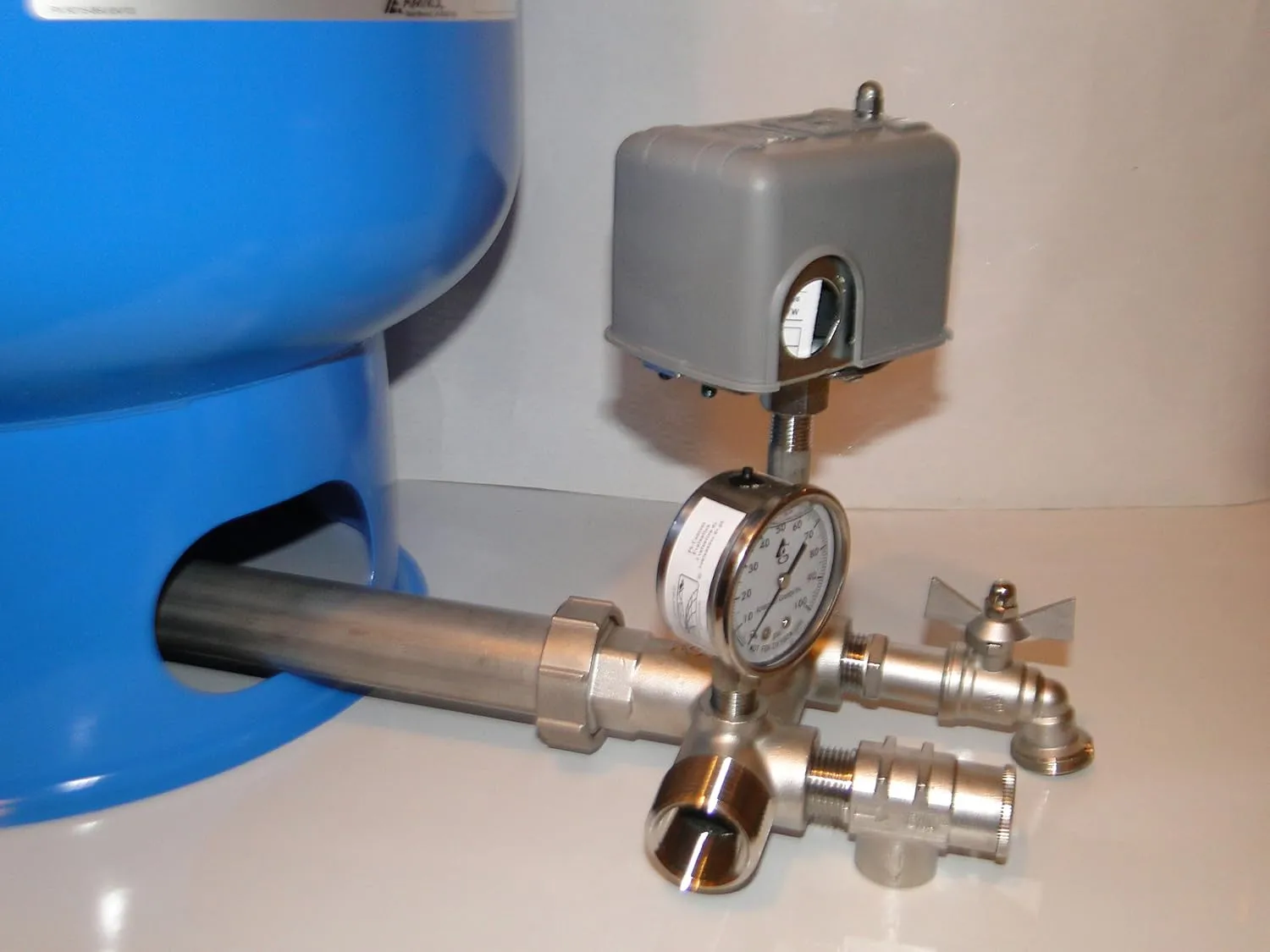If you’ve observed your submersible well pump cycling more frequently or difficulty getting water from your tank, it’s probable you’re facing issues with the pressure in your well tank. Low pressure in the well tank can harm the pump, change water pressure in your home, and lead to tank failure. If you suspect a loss of pressure in your well tank, understand how your well pressure tank operates and regularly check the water pressure.
In this blog post, we’ll discuss how to check the water tank pressure and provide tips to ensure your tank functions properly.
How do Pressure of Well Water Tanks Work?
Pressure tanks utilize air pressure to push water from the tank into your home, when you open a faucet.
A pump fills the tank with well water until the remaining air compresses enough to reach a specified pressure, measured in pounds per square inch (psi). Once the pressure inside the tank reaches the set psi, the water flow stops.
When you turn on a faucet, the pressure in the tank pushes water through the pipes. As the pressure decreases to a specific psi, the pump activates to refill the tank.
Typically, the maximum pressure in a tank ranges from 40 to 60 psi, causing water inflow to cease when the air compression reaches that level. Water starts pumping in again when the pressure drops to around 20 to 40 psi.
What Is The Ideal PSI For My Well Tank?
The psi reading of your tank should be 2-3 psi, lower than the tank’s cut-on psi setting. The cut-on psi is the pressure level in the tank that activates the pump to draw water from the well into the tank.
If you’re unsure about the cut-on setting, locate the tank’s pressure switch and remove its cover. Inside the cover, you’ll find a specifications sticker indicating the cut-on and cut-off pressures.
The lower number represents the cut-on pressure that triggers the pump, while the higher number is the cut-off pressure that halts the water flow.
For example, a tank marked as 20-40 psi has a cut-on psi of 20 psi and a cut-off psi of 40 psi.
When checking your tank’s pressure after turning it off and draining it, its psi should be 2-3 psi below the cut-on number.
For instance, if a tank’s cut-on psi is 30psi, the pressure when the tank is off and empty should not exceed 28psi.
Is 70 psi good?
Water pressure of 70 psi isn’t excessive, but can damage old pipes. Pressure higher than 70 psi depletes the tank faster, increases pump wear, and raises water usage.
Is 100 psi High?
Yes, 100 psi water pressure can severely damage home plumbing and too much utilizing water appliances like dishwashers and washing machines.
Ideal Psi for a Water Tank?
The ideal psi for your water tank typically ranges from 40 to 60 psi. Most well water appliances work best in this water pressure.
How to Check Well Water Tank Pressure?
To check your water tank pressure, you will need these dial or digital pressure gauges:
- Switch off the breaker to cut off electricity supply to the tank.
- Completely drain the tank by opening a faucet. Once empty, the air regulator on the tank will display 0 psi.
- Locate the air valve, commonly referred to as the Schrader valve, typically situated at the top and covered with a silicone or rubber cap similar to a tire valve stem.
- Take off the cap, then unscrew the metal valve cap.
- Utilize your pressure gauge by pressing it onto the valve to check its reading.
How to Change the Pressure Settings of a Well Water Tank?
Ensure safety by disconnecting the power supply and turning off the breaker. Gather necessary tools such as ruler, tape measure, or tool for measuring, and ⅜-inch socket. Locate the pressure switch, identified by two rods with springs and nuts at the top.
The larger rod sets the cut-in psi level. The smaller rod determines the differential between cut-on and cut-off psi, typically maintaining a 20 psi difference. Measure from the top of the bolt down to the first exposed thread above the nut on the larger spring to track adjustments.
Reset measurements if needed to start adjustments anew.
To Change the Well Tank’s Settings
- Rotate the nut counterclockwise to reduce the cut-in psi level.
- Rotate the nut clockwise to raise the cut-in psi level.
- Typically, one full rotation of the nut results in a 2-3 psi adjustment.
- The cut-off pressure will increase or decrease by the same amount, ensuring they remain 20 psi apart unless your tank has unique settings.
What Reasons To Lose Well Water Pressure?
Your well pressure tank may experience pressure loss due to several reasons:
1. Frequent Usage without Refill
Continuous water use without allowing time for the tank to refill can lead to pressure drops, indicating an undersized pump for your needs.
2. Leaks
Leaks in the tank or valves can cause pressure loss, similar to how a ruptured bladder affects pressure in bladder tank systems.
3. Dirty Supply Pipes
A dirty supply pipe from the tank can reduce water pressure, even with normal tank pressure, by restricting water flow.
Why Does Water Coming out of Air Valve On a Well Pressure Tank?
If you find water coming out of the air valve when checking the pressure of your well tank, it indicates a ruptured bladder. Unfortunately, this requires replacing the well pressure tank. If water leaks from the Schrader valve, it suggests a compromised barrier between air and water.
Moreover, if you’re unable to add air through the Schrader valve with an air compressor, it usually indicates bladder failure. Sometimes, tanks may continue to function briefly after bladder or diaphragm failure. You might even be able to add air and draw water from it.
However, the damaged bladder will cover the water inlet, preventing water withdrawal. You’ll also notice rapid cycling of the well pump and shorter draw down cycles.
A tank with a failed bladder cannot be repaired. To protect your pump and restore water to your home, replace a tank with a ruptured bladder promptly.
What Happened If Well Pressure Is Too Low (detect or solve low psi)
If the pressure setting of your well pressure tank is too low, water will flow through your pipes at a slower rate due to reduced pressure. Appliances requiring water will take longer to fill up, and water from faucets, taps, and shower heads may trickle out slowly.
Adjusting the cut-in psi of the tank will increase the pressure inside the tank, resulting in higher water pressure throughout your home.
However, if the tank repeatedly loses pressure, it could indicate a ruptured or leaking bladder in a bladder pressure tank. This leads to the bladder stretching excessively as water enters the tank. Pipe leaks can also contribute to pressure reduction. You need professional advice when the pressure is too low.
What Happened If Well Pressure Is Too High (detect or solve high psi)
Excessive pressure in your well tank can lead to rapid cycling of the pump and may cause valves like the Schrader valve to rupture.
When checking the tank’s pressure while it’s turned off and drained, if the pressure exceeds 2-3 psi below the cut-in psi level, it’s necessary to bleed the tank. This involves releasing air until the pressure decreases.
To bleed the tank, press the pin in the center of the Schrader valve for one to two seconds. Measure the pressure again, and repeat the process until the pressure reaches the appropriate level.
How Do You Know If Your Water Pressure Tank Is Bad?
There is some commons signs of a bad pressure tank:
- Frequent or irregular cycling of a water pump is often reflected in a high electricity bill.
- Fluctuating pressure on the pressure valve connected to the tank, moving both up and down.
- When turning on faucets, air sputters out.
- Water may come out too hot due to air in the cold water supply, while clicking sounds can indicate a waterlogged tank, suggesting it may be full of water.
- A decrease in water pressure or complete absence of pressure.
- Water spurts from the air valve when you press the pin.
- Leaks originating from the tank.
How to Clean Tank’s Well Pressure?
Similar to other water-related appliances, pressure tanks can become contaminated by sediment. To clean your water pressure tank, follow these nine steps:
- Switch off the power at the breaker.
- Connect a garden hose to the spigot located at the bottom of the tank.
- Direct the other end of the hose to drain outside or into a large bucket, then open the valve to drain the tank.
- Use pliers carefully to remove the air regulator located on top of the tank, which displays the pressure inside the tank.
- Unscrew and remove the access hatch located on top of the tank.
- Clean the inside of the tank and remove any sediment or particles accumulated at the bottom.
- Utilize steel wool to scrub away any sediment deposits adhered to the tank.
- Screw the hatch back into place and reinstall the air regulator.
- Detach the hose and close the drain valve. Then, switch the breaker back on to allow the clean tank to refill.
Conclusion
Maintaining proper air pressure in your well water tank is crucial for ensuring efficient water flow throughout your home and preventing damage to your pump and plumbing system. By regularly checking and adjusting the tank’s pressure settings within the recommended range of 40 to 60 psi, you can optimize its performance and longevity.
Additionally, being aware of common signs of pressure tank issues and knowing how to clean and troubleshoot them can help you address any problems promptly, ensuring a consistent water supply and avoiding costly repairs.
Overall, prioritizing the maintenance of your well pressure tank is essential for the smooth operation of your water system.
FAQs
How much should air pressure be in a well water tank?
The recommended air pressure in a well water tank typically falls within the range of 40-60 psi below the “cut-in” pressure of the pump.
How often should I check the air pressure in my well water tank?
It’s recommended to check the air pressure in your well water tank at least once a year, or whenever you notice a decrease in water pressure.
Why does the air pressure in my well water tank decrease over time?
Air pressure can decrease due to factors like temperature changes and air absorption into the water.
How can I check the air pressure in my well water tank?
You can use a tire pressure gauge to check the air pressure at the air valve located on the top of the tank.





